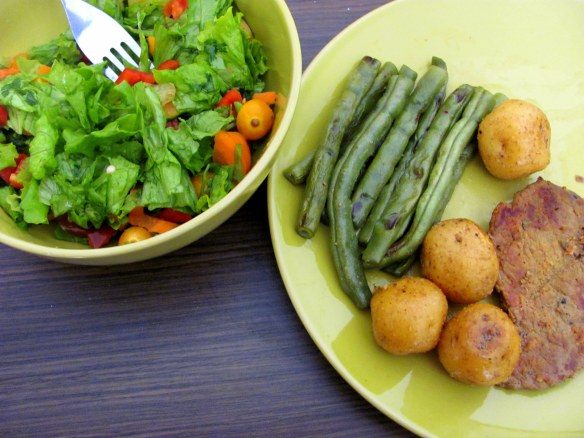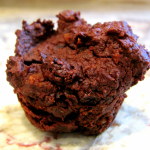In North America, we are faced with a problem that is unique to our side of the world: over-abundance of food. We lack the traditional foundations of eating, most of us have spent our childhood in classrooms and in front of televisions, not helping our grandmothers need dough for gnocchi or boiling tomatoes for canning for the winter. Few of us know how to make bread from scratch or ferment milk for yogurt. Our time is slim and the emergence of the empowered, working female has taken us out of the kitchen and into the supermarket or restaurant where food brands compete for our attention, promising us lucrative health claims, confusing the matter even more.
When I travel, people from other countries ask me what a typical “Canadian Dish” is. I, think of how my favourite food is Ethiopian injera and stews or how we often celebrate by going out for sushi, taking part in enjoying cuisine from two different countries I have yet to visit. This is one of many reasons why North Americans are confused about what to eat: we lack a gastronomical identity and, because we don’t have our roots to guide us, we’re left in the dark, reading labels and feeling utterly confused.
However, eating well is a simple equation coined by author Michael Pollen, “Eat food. Not too much. Mostly plants.” This healthy eating ideology outlines the importance of eating something called “whole foods”, the holy grail of healthy food, which basically include food that is minimally processed, in its whole, natural form.
Putting this philosophy into practice may not always be easy, however, so here are some simple rules:
1) Make things at home whenever possible: This means making your own salad dressing (if there’s one thing I can’t stand, it’s store-bought salad dressing) using your favourite combination of oils, vinegar, mustard, honey, hummus, tahini, etc. Make your own pancakes, muffins and cookies rather than buying mixes. This ensures that you know exactly what is going into your food, and hence your body. It also gives you the freedom to play around with food, exchanging out less healthy fats, like corn or vegetable oil, for healthier ones, like olive or coconut oil, decreasing sugar and adding more fibre and protein.
2) Eat fruits and vegetables: Are you stuck on what to eat: Rice cake and peanut butter or carrots and hummus? When in doubt, go for the fruits and vegetables. Rather than building a meal around the meat or grains in it, focus on vegetables when trying new recipes. Make vegetables the bulk of your meal by swapping pasta for spaghetti squash, making pizza dough out of cauliflower and filling your plate 50% full of vegetables (making protein and grains the other 50%). When having seconds, serve yourself more veggies. When snacking between meals, snack on fruit and veggies.
3) Don’t buy anything with more than 5 ingredients: When was the last time you were walking in the forest and saw an aspartame tree? If the product in your hands has more than 5 ingredients and you’ve never heard of or can’t pronounce some of them, put it back on the shelf. If you don’t have an idea about how this product is made (i.e.: you couldn’t make it at home, with ingredients in your kitchen), then your body probably doesn’t know how to process it either. Real yogurt contains two ingredients: milk and probiotics and yet most ygurts on the shelf have more than 5 ingredients. Always question why these ingredients might be there; chances are it’s not for your health.
4) Don’t buy anything fat free: One of my pet peeves is fat-free yogurt (see the point above). If the food naturally has fat in it, then eat it with fat! Fat free foods usually contain extra sugar and chemicals to give the food that satiating mouth-feel and preserve the flavour. Plus, you’ll probably end up eating more of the food, in order to feel the same level of satisfaction you’d get from eating the product if it just contained fat.
5) Stay out of the frozen food section: Make your own meals, cook your own meats and prepare your own food in bulk on the weekends or weekdays when you have some time. Then freeze portions of them for a rainy day. This saves you serving you and your family frozen, processed “edible food-like substances” full of preservatives, artificial flavours and other unhealthy chemicals. Likewise, don’t trust food that doesn’t need to be cooked, unless it’s a fruit or vegetable. If you just open a package and pop it in your mouth, or warm it up in the microwave, treat it with the utmost suspicion, and then go have an apple instead.
6) Eat food that is as close to its natural form as possible: The word “processed” is often a misnomer. The truth is, in order to consume most food, it must be processed in some form; cooking, after all, is a form of processing food. However, with each stage of the food preparation process, nutrients and flavours are lost and chemicals, preservatives and flavour-enhancing like salt and sugar, are added in. That is why it’s important to eat food that is as close to its natural state as possible. For example, when deciding what the best oatmeal to buy – steel-cut oats, large flake oats, quick oats and instant oats with maple and sugar flavour – choose the ones that have been tampered with the least. They contain the most soluble fibre, the least sugar and no preservatives. The more processed you get, the lower the nutritional value of the food.
7) Drink water: stay away from juice and pop. These things do nothing for your health and are a source of extra sugar and empty calories. Stick to “real” drinks like water, herbal tea, coffee, wine, and, you know, single-malt scotch.
8) Don’t buy any food that has a TV commercial: We’re rarely sold what we need. How often have you seen apples advertised during a prime time commercial segment? If we’re being marketed food on TV, chances are that food is engineered in some way. Stick to whole, boring foods that have been around for a while and, therefore will never vie for your TV-viewing attention, like apples.
9) Don’t eat anything that didn’t exist 100 years ago: If your great grandmother ate it, chances are it’s a whole food. Our relatives lived in a time where commercial food processing wasn’t as commonplace as it is now and while a lot has changed, the human body has remained pretty much the same. Therefore, if the food you’re debating whether to eat or not didn’t exist 100 years ago, chances are, your body doesn’t know what to do with it. By default, this rule pretty much eliminates any microwavable food.









Reblogged this on idealisticrebel and commented:
The GMO information makes this sound worthwhile. Hugs, Barbara
Great Post! I enjoy making meals at home and Sundays give me a chance to make meals for the week too:) Happy Tuesday
Renee, long time no comment! How have you been? As usual, full of good health tips. I also enjoy making huge batches of things when I cook, because I know that, for me, cooking is not an endurance activity but something that happens sporadically, when I’m in the mood, therefore I always make extra for meals to come. Thanks for commenting! Happy New Year!
Super helpful information. Everyone should consider this when they eat and shop for groceries!
Thanks for the comment!